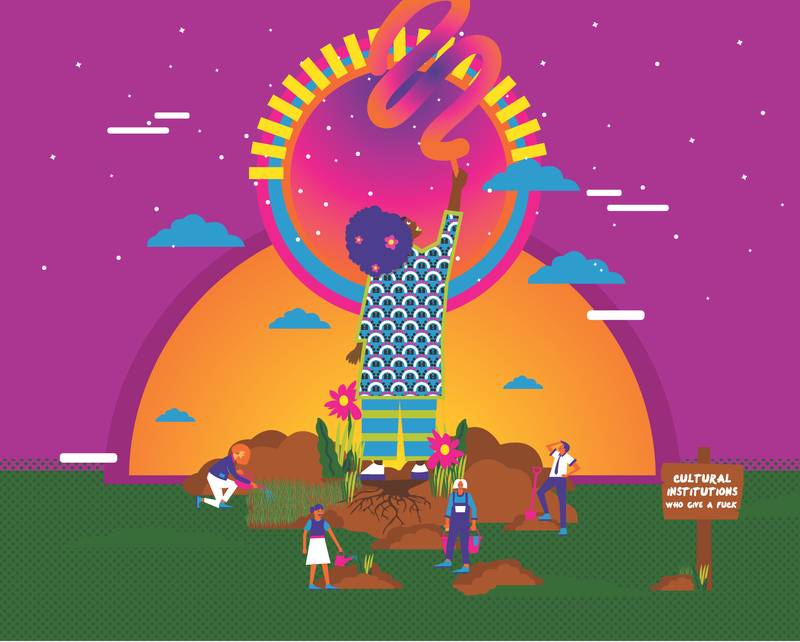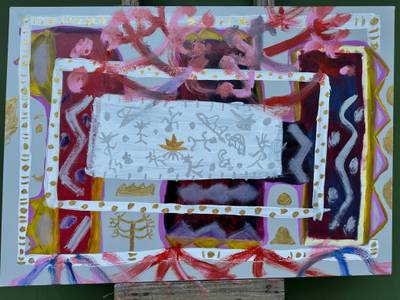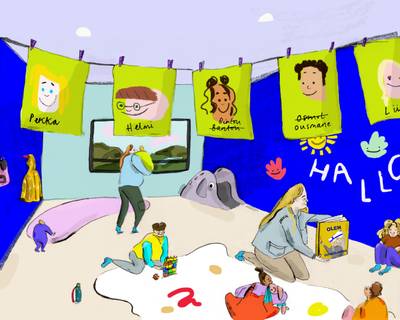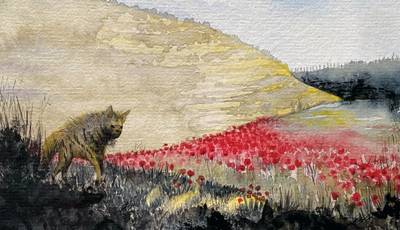

Illustration by Nontokozo Tshabalala
Fatoumata Laisa Conde is a producer and researcher aiming to shift the responsibility of anti-racist work in the art and culture scene. She is the creator of Healing & Dealing and is currently researching the connection between identity, public art and colonial discourse in west Africa and working as a project manager for Sarah Bekambo.
Cultural exchange is often seen as an event inviting someone to showcase or exhibit their art outside their home country or their part of the world. I’ve spent a year researching cultural exchange and the effects of whiteness on the art field, specifically in Senegal and The Gambia, and I even had a peek into Guinea. For my research, I defined cultural exchange as a socio-cultural event where an artist is invited to exhibit or showcase their art outside their immediate cultural context; this could be in another country or on the street they grew up on. We cannot use geography as the perimeter for cultural exchange; instead, we should look at the space where the exchange takes place. Who is curating, producing and inviting these artists? These are central questions defining whether the transference is cultural exchange or not. In this essay, I deconstruct the ‘power dynamics of cultural exchange’ from the perspective of Gambian and Senegalese artists and elaborate on how the room, respect, celebration, identity and negotiation play a pivotal role in cultural exchange.
I am a Gambian Finn based in Sweden and The Gambia. I grew up in Finland and have lived in Sweden for the past decade. In my work, I understand the topic through my experiences as a part of the Gambian diaspora. Throughout my living and work in both these locations, I have observed that Black artists are not treated fairly based on not being met on equal ground by institutions that invite them. Pressurising or expecting invited artists to negotiate away the essence of their art to accommodate the whiteness of white institutions is a form of violence so normalised that it is invisible. In the off-chance that this violence is questioned, it is the artists who become the cause of conflict and hence must be the finder of the solution (on white terms). During my research, I met artists from The Gambia and Senegal, many for the first time, to talk about life, art and working with institutions. Even though these artists do not work with each other, the story of white violence keeps repeating itself in their words.
I recently returned from home and came back to Sweden, to a place that should also be home but is not. When I got here after eight months at home, it took my neighbours five weeks to start greeting me. I consciously tried to go to exhibitions and seek art-related contexts to immerse myself. My go-to line for myself was, ‘Laisa, you belong exactly where you decide to belong’, but do I?
Reading the Room
Four walls with a floor and a ceiling make a room. It is a basic structure of a space. Spaces are political and embody joy, trauma, privileges, and emotions. A space has rules, both spoken and unspoken. Is it okay for me, a 29-year-old mixed woman, to exist in these spaces?
When I visited Moderna Museet in Stockholm a week ago, one of the guards at the museum followed me around the entire museum. It became amusing when I walked through Maurizio Cattelan’s exhibition, The Third Hand. In one of the rooms, there is a gigantic hand with a middle finger in the air. I walked around the monumental sculpture a few times and could not help but giggle over the guard following me around the sculpture while my anxiety grew. Most of my energy was used to ground myself and convince myself I belonged in that room. Even though I recount this incident light-heartedly, it is a grim reality and a common occurrence for many.
There is a growing need for explicitly Black spaces for artists and cultural workers to have breath and distance themselves from whiteness. The notion of Black people needing their own space is important. And even if a space with only Black people does not mean it is a safe space, it significantly decreases the risk of white violence in that space.
Fehe Sarr, an artist I interviewed in Senegal, described the unspoken rules of space using the example of rooms in our homes. Understanding the room as a mirror of the power structures allows us to understand the setting and view the base of the conversation from the artists’ perspective. When guests come over, they know which rooms they are welcome and which rooms they are expected to stay out of. These boundaries with our guests are both articulated and unarticulated. In the same way, an artist knows and senses the limitations of spaces in institutions intended for cultural exchange. Institutions must extend this autonomy to the artists to set boundaries with the audience in those spaces. For Fehe, this means preferring an audience with which he can resonate.
There is a growing need for explicitly Black spaces for artists and cultural workers to have breath and distance themselves from whiteness. The notion of Black people needing their own space is important. And even if a space with only Black people does not mean it is a safe space, it significantly decreases the risk of white violence in that space. I feel at ease navigating in The Gambia as the social norms are logical; I know what is expected of me and others, what rooms I am welcomed in, and which are not. I know which rooms my proximity to Blackness gives me access to just as I know which spaces my proximity to whiteness gives me access to.
Sara Ahmed said To be not white is to be not extended by the spaces you inhabit (Ahmed, 2006, p. 111)1. This is also true in the case of cultural exchange, with the difference that cultural exchange often occurs in places where someone who would identify as Black in a Western context might not be considered Black. This is because societal structures in that particular geo-political location do not force them into a narrow definition of Blackness. Instead, they might identify as, for example, Senegalese rather than Black Senegalese.
Last year, sitting in the most beautiful setting at a beach bar just outside Saly in Senegal, I met Ami Weickaane. Ami told me about an experience where she was invited to exhibit by a white institution in her home country, Senegal. In Senegal, Black people don’t generally identify as Black or non-white because they are the majority and don’t live in the same structures. Ironically, she was used as a token, as the ‘good’ Black person, because she had lived in the West for a significant amount of time. The institution alluded to her being better than her own [people] because she had been sensitised to the West and would better understand and adapt to the institutional context. While the institution saw this as a compliment, Ami found it insulting. Ami may have had her guard down at the initial encounter since it was her home setting, where she was fluent in the social codes. The encounter must have shocked her, as it occurred in her ‘home’ setting, revealing how whiteness, while enjoying its privileges, can infiltrate even seemingly safe spaces, imposing its violence on an artist within their own home setting, regardless of the artist’s adeptness in that location.
Queer theory articulates how the existence of a Black body in spaces disrupts the space by merely existing in it.
Some bodies more than others are ‘in line’… Whereas other bodies, those who are not white or heterosexual, for example, are already out of line, disoriented by how they are ‘seen’ or encountered in public spaces (Ahmed, 2006, p. 111).
When this theory is applied to cultural exchange, one can understand how inviting a Black artist to exhibit their art in a white context without taking actions of active care undermines and devalues the artist, their creativity and their work. To ensure that the artist and their art are heard, active steps such as showing interest in the art by asking questions about the creative process, giving the artist time to explore their creativity and ensuring the artist that their art will be handled with care by professionals are fundamental.
Negotiations
For artists, negotiation is a significant part of their work. Artists negotiate based on their creativity and individual interests, determining their compensation and how they and their art will be presented and contextualized. These negotiations often start at the initial meeting, where the frame for the exchange is set and continue throughout the collaboration both in the active, the exhibition or showcase itself, and in the afterwork where the institution is convincing the artist that it was the right thing to do, giving into whiteness and changing their work and vision to accommodate whiteness. While artists generously contribute to cultural exchange initiatives, it’s essential to ensure that their efforts are adequately valued and reciprocated. Artists recognize the advantage of having one more exhibition or collaboration on their CV. However, institutions exploit this advantage by prioritizing their needs and expecting the artist to accommodate the institution’s “wants and needs” (read whiteness and the white gaze in cultural exchange).
Often, the scenario is such that the artist is coerced to hold back their ambition for the project and their visuality, modify their intellectual property, and simultaneously sacrifice parts of their integrity. At the same time, the institutions get to maintain their guidelines, policies, integrity and visions. These circumstances lead to a situation where the artist and their work are unequal to the institution’s position in curating the exchange. This creates a power play where the artist is put on the spot where they are expected to comply with the institutions’ vision or be prepared for the collaboration to end and risk financial loss or a dent in their cultural capital.
Artists can become as vigilant and competent, but institutions with far more resources and collective time have the bigger responsibility to be sensitised enough to ensure that all steps and measures are taken to ensure the artist feels supported, safe, and welcomed during their collaboration. Several artists from different disciplines I have met several artists who share this experience of cultural exchange – a constant negotiation where the artist seldom benefits or has the upper hand.
Ami spoke about how important it is for the producer of the exhibition to understand the content of the project; she emphasised the importance of regular meetings between the artist, the artworks, and the production team. “The issues I have are always located in the fact that people don’t take the time to understand exactly what I want to say and why.” Ami’s work, Woman, Water, Life, one of her most recent works, reflects the resilience of women who carry and nurture life while symbolising the critical situation of a planet that is dried up by neglect and exploitation. Through a symbolic ritual, I make it clear that women and our drying planet are two entities that, deprived of their vital essence, struggle to perpetuate life. Ami draws her inspiration for her work from her life, her experiences as a woman, as a traveller, as an expat, and her understanding of the environment where she lives and as a Black woman. Her blackness is a part of it, but not all of it. According to her, if the communication between the production team and the artist is not working, it will negatively impact several aspects of the exhibition. Ami shared an experience where she had to negotiate her boundaries, her art and being, having to settle and give where she was uncomfortable. She is not alone in her experience.
I interviewed Lena Nian, a photographer based in The Gambia. Most of her pictures portray Black bodies, and it is often assumed she is using Black bodies in her work to speak on the Black experience and give Black individuals a voice when she is just taking pictures of what inspires her and the reality is that living in The Gambia most people around her are Black.
We need to allow these artists to exist and create without policing or forcing them into only one narrative when they are multi-dimensional in their work and talent. Let’s stop assuming all Black artists are making art to fight the Black fight and afford them the complete human experience of creating and doing what their creativity calls for.
Artists can become as vigilant and competent, but institutions with far more resources and collective time have the bigger responsibility to be sensitised enough to ensure that all steps and measures are taken to ensure the artist feels supported, safe, and welcomed during their collaboration. Several artists from different disciplines I have met several artists who share this experience of cultural exchange – a constant negotiation where the artist seldom benefits or has the upper hand. There may be exceptions to the rule, but such instances are insufficient and do not indicate that we must let institutions off the hook.
Inviting artists to showcase their art outside of their cultural context comes with a responsibility that can’t be taken for granted or lightly. It’s high time that institutions that invite artists for cultural exchange start their work by trusting the artists to create their vision, hear them and check their privileges. Make sure someone is working in the team, and if needed, hire outside consultation, who the artist can relate to and who can relate to the artist and their art. Negotiation is a part of life, but giving artist space and freedom in their creativity will allow them to broaden it. It benefits everyone involved, including the audience that witnesses the final result.
What exactly is being celebrated
Cultural exchange has become trendy and institutionalised – made easy by inviting artists from a different culture. When the main focus is on showcasing the inviting institution in a positive light, is it possible to simultaneously appreciate the art, or does it merely become a case of celebrating the artist out of courtesy while maintaining the asymmetrical power relations at play?
The audience is a good indicator of who or what is being celebrated. Who is the target audience of the event, and why? Will there be an audience who understands and can resonate with the art and the artist, or is the exchange’s purpose to allow an audience to exotify the artist and their art while romanticising the white gaze?
Communicating the event only to a predominantly white audience is often detrimental to the art as it is not allowed to fully communicate and transmit the message it carries. By seeing artists as translators who use art as a tool to convey messages, one can understand the role of the audience in having to resonate with both the artist and the art. The curation of the space and the audience can thus allow or deny the audience the right to undermine the artist and their art. If they are allowed to undermine the artist, the audience becomes detrimental to the cultural exchange, and when this is a pattern, it becomes detrimental to the art and culture scene.
Reiterating the growing need for explicitly Black spaces for artists and cultural workers, Fehe’s idea about the artists having the autonomy to decide who their audience is shifts the power structures towards a more beneficial balance for the artist. Otherwise, the risk is that we celebrate whiteness and its attributes instead of celebrating the creative mind and the art.
Placing the responsibility of decolonisation on the artists, denying the artist the whole human experience of existing as a creative individual forces them to exist only as being Black, even in their creative space, that too with the expectation to conform to what is viewed as acceptable Blackness – parameters again set by whiteness. Colonial narratives are alive not only in the far-right politics raging around but also in the arts and cultural scene, and they are still being transported overseas in the form of cultural exchange.
Last spring, I participated in setting up an exhibition at the IFAN museum in Dakar, Senegal, which allowed me the time to engage with the works before the target audience arrived. On the first floor, there was a media library, M’BOKK, curated by Black Pages, a space aiming to make the museum more accessible and open it up to new audiences by starting the work of decolonising by recognising what some might call the objects of the museum as inhabitants suggesting that there could be a relation to build and to reconnect with the inhabitants. On the second floor, there was a group exhibition in a large room featuring artists from different cultures and countries. On the opening night, the atmosphere in the exhibition on the second floor was filled with white violence as the room allowed the white audience to exotify and appropriate the art. The exhibition description read as follows;
The exhibition weaves together anti-colonial and decolonial approaches and quests for transformative justice and ecological investigations while considering the different histories and positionalities of the contributors. While the coloniality of collections and their manifestations in the present are often the starting point, we strive to open spaces of invention and transformation beyond the museum.
The aim of being a decolonial and anti-colonial space was not fulfilled. The exhibition was free and seemingly open to all. Still, the questions of belonging and accessibility had not been considered enough to reach the majority population of the city. The ones that did come seemed out of place and uncomfortable, as did I. A part from M’BOKK navigating the exhibition on the opening night was like walking in Moderna Museet in Stockholm, wondering whether I could exist in this space. Meanwhile, the white audience seemed more than comfortable navigating, taking pictures of the art in a way that had me questioning if they were even seeing it as art or were there only to exotify and tick the box of ‘I’ve seen African art’? What could have been a beautiful celebration of the inhabitants of the museum turned into a museum of African art filled with white gaze and violence.
Institutions and cultural workers in the arts and cultural scene talk about decolonial and anti-colonial work. Black artists are expected to create art contributing to the anti-colonial and decolonial cause. At the same time, the white individuals working within them are afforded the privilege of ignorance concerning their actions that cause direct and indirect harm to Black artists by expecting the artists to accept and adapt to different situations instead of them [artists] being able to focus on their artistical work. Placing the responsibility of decolonisation on the artists, denying the artist the whole human experience of existing as a creative individual forces them to exist only as being Black, even in their creative space, that too with the expectation to conform to what is viewed as acceptable Blackness – parameters again set by whiteness. Colonial narratives are alive not only in the far-right politics raging around but also in the arts and cultural scene, and they are still being transported overseas in the form of cultural exchange.
Reimagining
To see oneself in art, public or not, tells us that we exist, that our voice is essential and that we have a say in our surroundings. Minoritized artists should not be used as tokens of representation. Instead, they should be treated as artists with authorship and agency. Expecting Black artists’ work to centre around Black pain and suffering or being a part of the fight for Black liberation is not only unreasonable, it can also be devastating for the artist’s creativity. We need to see these artists for who they are. They are artists, not soldiers, who want to liberate their people or community. Artists with creative minds and the talent to express that creativity in the form of art should have the space to express what they feel is essential to their art. For example, the success of West African artists has led to a repositioning and redefining of what it means to be a West African artist in a globalised world. This allows a more diverse cultural expression to contribute to a complex and multifaceted understanding of the artist’s identity. This repositioning of cultural identity reflects the changing dynamics of cultural exchange and the power dynamics at play as the parameters for how the individual is allowed to exist have widened. The changes are far from perfect, and the gaze at them is still narrow and unimaginative. Nevertheless, it has afforded artists from the region more freedom in expression, fostering the development of an artistic signature style and using it without always compromising and “toning it down”.
By understanding the interconnection of identity and power and how identity can shift and be repositioned, we can appreciate the blend of cultural influence, exposure, and consequences. The difference between feeling respected and being respected is not as straightforward as one would wish regarding cultural exchange. The power structures at play blur the dynamics, creating asymmetrical power relationships. The artist is left to fend for themselves, usually unsupported by the institution, and the institution has the power to make the final decisions. Artists need respect and a shift in the power structures. To truly respect the artists and even attempt to level the playfield of power, the white gaze has to be corrected and checked. Institutions use cultural exchange as a tool to achieve their goals of diversity, equity, and inclusion, helping them climb a social and moral ladder without actually including Black artists in a way that would be mutually respectful and fruitful. They have an evident talent for verbalising what needs to be said, and they seem to understand words having power. However, those words still need to lead to consistent action so that the words do not lose that power. How is the arts and cultural scene viewed as progressive when it still can’t afford Black artists the whole human experience?







